A wave of severe storms that brought hail and high winds to places such as Texas and a string of states in the central U.S. in recent months is wreaking havoc on insurers’ profits.
Auto- and home-insurers, already struggling with rising repair and replacement costs, are expected to keep boosting premiums to offset the big upturn in weather-related losses.
Bellwether insurer Travelers on Thursday said “numerous severe wind and hail storms in multiple states” sent it into the red in the three months through June. The company reported a near-doubling of catastrophe losses to $1.5 billion for the second quarter, up from $746 million for the same period last year.
The bad weather is piling pressure on property-casualty insurers as they try to chart a path back to profitability by pushing through big premium increases, particularly for autos.
Allstate announced Thursday catastrophe losses of more than $1 billion for last month, pushing its tally for the second quarter to $2.7 billion. That is more than twice the $1.1 billion total for the same period last year.
The insurer said it is continuing to “implement significant auto and homeowners insurance rate actions as part of our comprehensive plan to improve profitability.”
Since the start of the year, Allstate has increased premiums on its own brand of auto insurance by about 15%, which is expected to raise revenue by around $1.95 billion a year, according to BMO Capital Markets and the company.
The latest uptick in catastrophe costs stems from a series of storms across the country, in contrast to years such as 2011 when one or two big tornadoes or other disasters accounted for the lion’s share of the losses, according to reinsurers.
“Almost no place has been safe from severe weather” in 2023, insurance broker BMS Group said in a report this month. Seven states have this year racked up insured losses of more than $1 billion, with Texas suffering most with $7.2 billion of damage, the report said. It named the other six states as Illinois, Kentucky, Colorado, Tennessee, Arkansas and Missouri.
The number of weather events causing severe insurance losses in the past two years has been the highest since at least 2010, according to BMS, which analyzes weather patterns for insurers. The losses were higher this year likely because of the impact of inflation. Another factor on losses is whether the storms hit populated areas.
The three months through June are “potentially the industry’s costliest quarter for hail losses in history,” according to John Roche, president and chief executive of the Hanover Insurance Group. His company Thursday announced estimated catastrophe losses of $262 million for the second quarter, more than triple the $77 million for the same period last year. The second-quarter losses stemmed from 19 storms across several states, Hanover reported.
The pummeling from hail and wind has extended beyond the central U.S., with California and Florida also experiencing high levels of unusually severe weather this season, according to BMS.
The resulting damage to cars and houses appears to be an industrywide headache for property and auto insurers.
In at least some cases, the bad news appears to be taking investors by surprise. Progressive last week spooked the market when it reported higher-than-expected June underwriting losses. The insurer’s shares took a double-digit tumble after reporting what analysts at Piper Sandler called “one of the toughest [months] it has suffered in recent years.”
Weather-related losses were a leading cause of Progressive’s pain. Its catastrophe losses tallied 6.3% of auto premiums in June, likely double the normal for that month, Piper Sandler said.
Travelers on Thursday said the bad weather was masking improved performance on other financial fronts. Alan Schnitzer, the company’s chief executive officer, said the historic level of industrywide catastrophe losses had offset strong underlying results and investment returns.
Travelers posted a net loss of $14 million for the three months through June, compared with a $551 million net income for the same period the year before. The insurer lost 6.5 cents for every dollar in premium written in the second quarter, the company reported.














